Rolls-Royce swimming pool stunt prompts musical retrospective
Phantom embraced by artists from Marlene Dietrich, Elvis and Sir Elton John to John Lennon, Liberace and 50 Cent
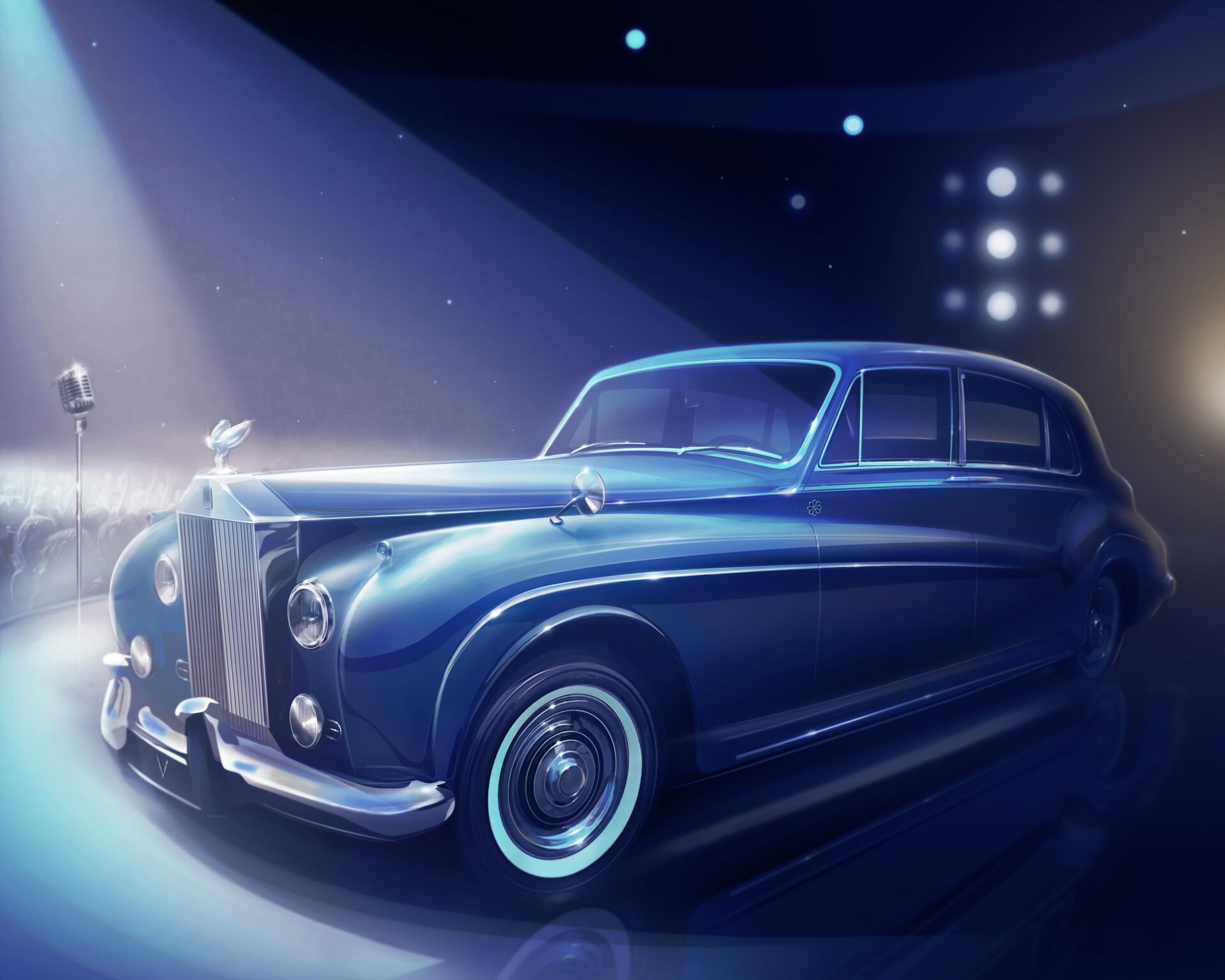
This week’s submerging of one of its own Phantom limousines (worth a cool half-a-million quid) into a swimming pool – to mark what would have been Keith Moon’s 79th birthday and the centenary of its literal and actual flagship model – was a spectacular step into music folklore for Rolls-Royce. Insert gag about making a splash here.
But this homage to the late The Who’s drummer sent us scurrying into the archive, as it seems the Rolls-Royce Phantom’s association with the world of music is as wide as the pool it’s just emerged from is deep.
Long before icons like John Lennon, Elvis Presley and Pharrell Williams wrote themselves into Phantom history, artists including Duke Ellington, Fred Astaire, Count Basie, Ravi Shankar, Edith Piaf and Sam Cooke all travelled by Rolls-Royce, recognising the brand as the definitive symbol of success and artistry.
Personalities for whom the term ‘music mogul’ was created, including Brian Epstein, Berry Gordy and Ahmet Ertegun, were also among the marque’s most notable owners. Across genres, geographies and generations, a Rolls-Royce (and the Phantom especially) appears due reward for creative brilliance and a canvas for personal expression.
Rolls-Royce CEO Chris Brownridge tells us: “From the Golden Age of Hollywood to the rise of hip-hop, over the last 100 years, music artists have used Phantom to project their identity and challenge convention. Their motor cars often became icons in their own right, with a lasting place in the history of modern music. This enduring connection reminds us that Rolls-Royce and the extraordinary people who are part of the marque’s story are united by one ambition: to make their presence felt.”
And here are some of the greatest hits:
MARLENE DIETRICH: FALLING IN LOVE AGAIN
Most actors travel to Hollywood in search of stardom. Marlene Dietrich arrived already part of the constellation. Fresh from her breakout role in The Blue Angel, and having introduced the world to what would become her signature song, Falling in Love Again, she travelled to California in 1930 to begin filming Morocco. Her welcome was as dramatic as her screen presence: at Paramount Studios she was greeted not only with flowers but with the gift of a green Rolls-Royce Phantom I. Morocco earned Dietrich an Academy Award nomination – and her Phantom also took its share of the spotlight, appearing in the film’s closing scenes and publicity images.
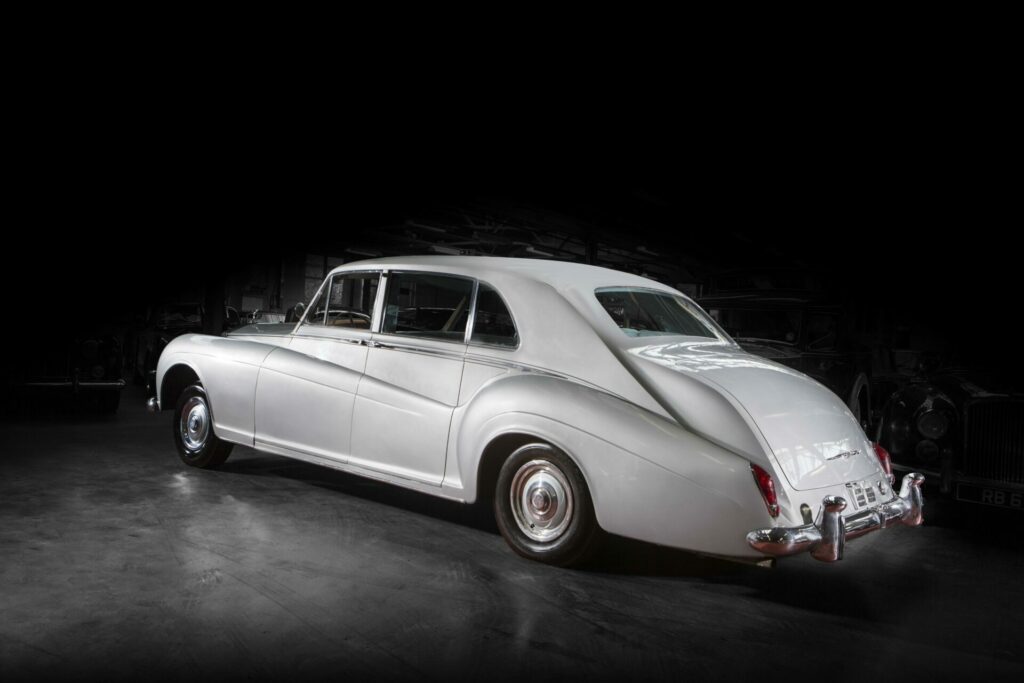
ELVIS PRESLEY: ALL SHOOK UP
In 1956, a self-titled album by a promising young singer named Elvis Presley became the first rock’n’roll album to top the Billboard chart, where it remained for 10 weeks. In 1963, at the height of his fame, ‘The King’ bought a Midnight Blue Phantom V with a host of bespoke features.
In what may have been an early version of in-car karaoke, the features included a microphone, a writing pad in the rear armrest – ready for flashes of inspiration – along with a mirror and clothes brush to ensure Elvis was always ready to make an entrance. In a charming domestic detail, the original mirror-polished paint famously attracted the attention of Elvis’s mother’s chickens, which would peck at their reflection in the coachwork. The motor car was subsequently refinished in a lighter Silver Blue that did not show the chips.
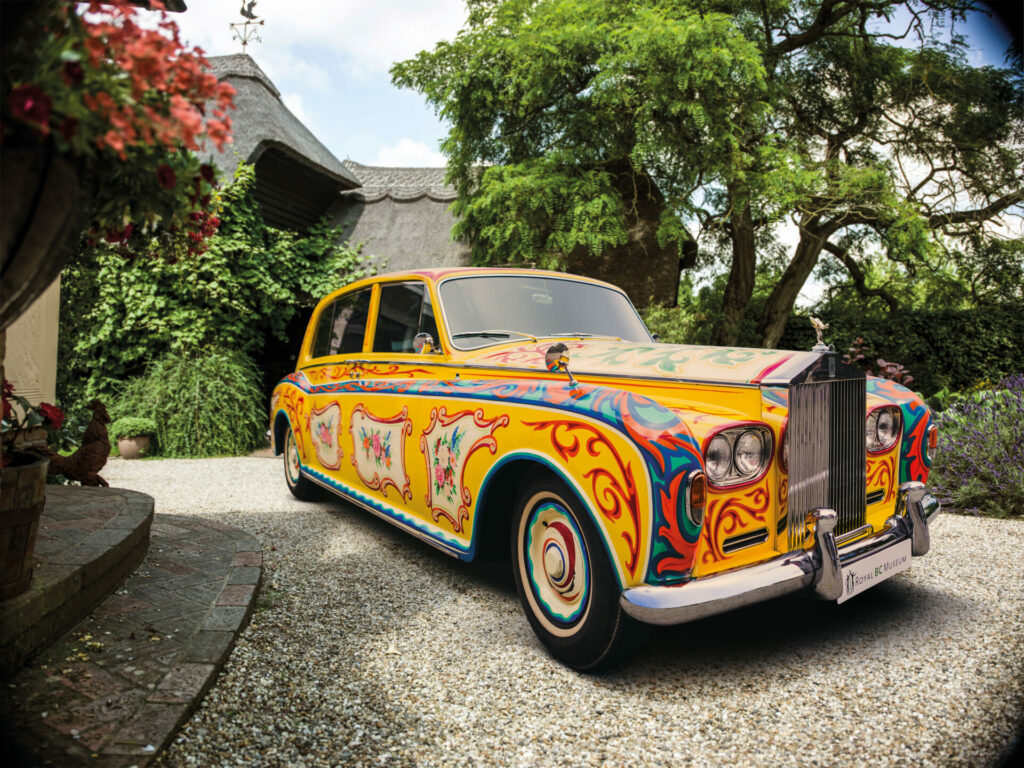

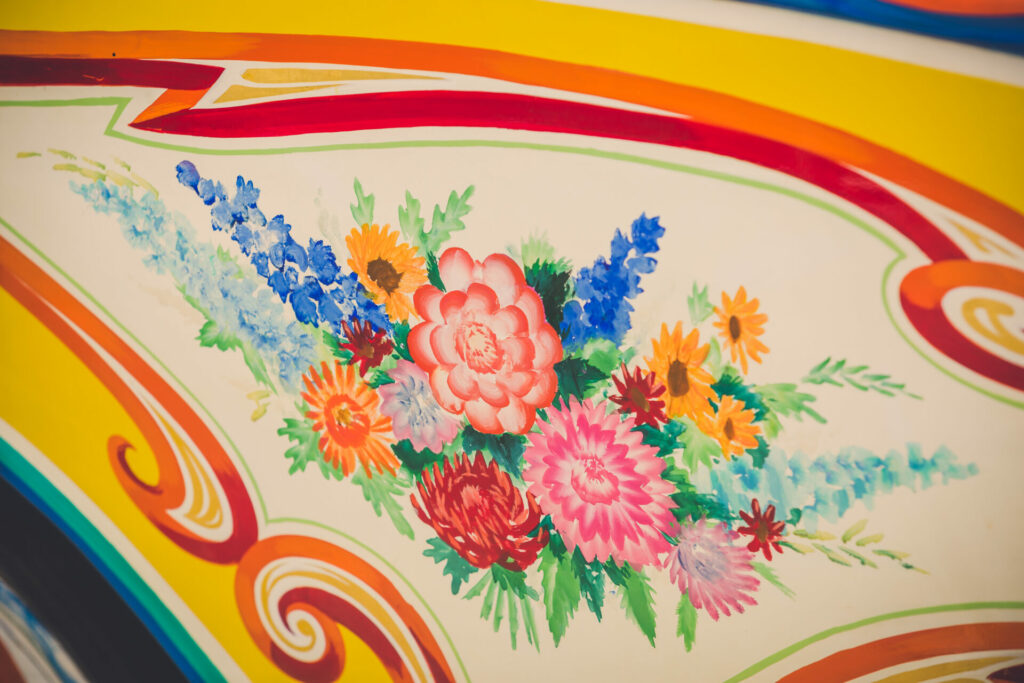
JOHN LENNON: LOVE ME DO
In December 1964, John Lennon rewarded himself for The Beatles’ A Hard Day’s Night by commissioning a Phantom V. The motor car was entirely black, including the windows, bumpers and hub caps; it also boasted a cocktail cabinet and a television, as well as a refrigerator in the boot. However, like Elvis’s Phantom V, Lennon’s would also undergo a complete transformation.
In May 1967, just before Sgt Pepper’s Lonely Hearts Club Band was released, the motor car was resprayed yellow, then hand-painted with swirls of red, orange, green and blue, with floral side panels and Lennon’s star sign, Libra, completing the motor car’s new persona.
For the younger generation, Lennon’s Phantom perfectly captured the mood of the carefree ‘Summer of Love’ that year. To their elders, it was an outrage, memorably summed up by a woman who, on seeing the Phantom driving down London’s Piccadilly, shouted, “How dare you do that to a Rolls-Royce!” before swatting at the paintwork with her umbrella.
When the car sold in 1985 it reached $2,299,000, almost 10 times the reserve price. It was both the most expensive piece of rock ‘n’ roll memorabilia at the time, and the highest price ever achieved for a motor car sold by auction.
This Phantom is arguably the most famous Rolls-Royce connected with Lennon, but he owned another. Lennon purchased a white Rolls-Royce Phantom V in 1968 to coincide with the launch of the White Album and to mark a new phase of his life with Yoko Ono. This was characterised by his wearing white clothes, decorating the interior and exterior of his Berkshire home in bright white, and pursuing a distinctly minimalist aesthetic.
Originally commissioned in a two-tone black-over-green by Wing Commander Paddy Barthropp, a wartime Spitfire pilot turned chauffeur, Lennon individualised this motor car in line with his personal style at the time. He paid £12,000 – equivalent to the price of a sizeable house at the time – to have the motor car transformed to white inside and out, and had it fitted with a sunroof, Philips turntable, 8-track player, telephone and television.
It would later appear in the Beatles film Let It Be, as well as Performance, which starred Rolling Stones frontman Mick Jagger. In September 1969, Lennon sold the car to Allen Klein, founder of ABKCO Records and the Beatles’ manager at the time, for a reported $50,000.
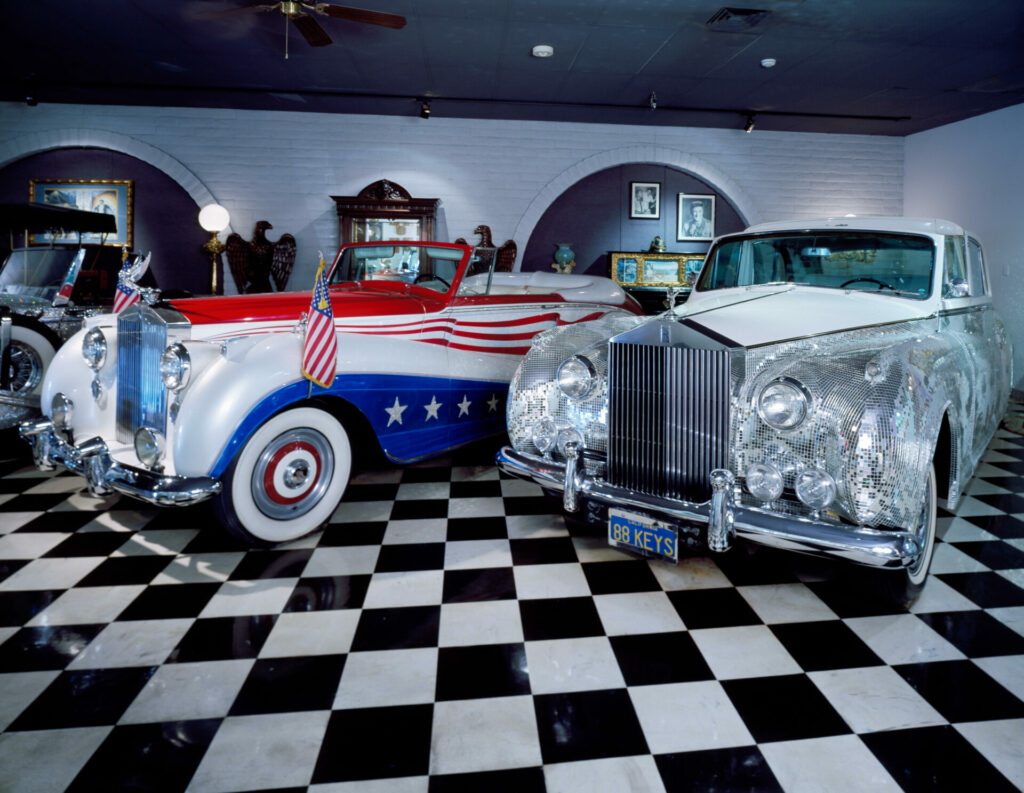
LIBERACE: I’LL BE SEEING YOU
Another musical iconoclast was Władziu Valentino Liberace. Flamboyant and multi-talented, Liberace was the world’s highest-paid entertainer in the ’50s and ’60s thanks to his TV appearances and shows in Las Vegas. Among the extravagances that earned him the soubriquet ‘Mr Showmanship’ was a 1961 Phantom V covered in tiny mirror pieces that he would use to drive on stage during his long-running residency at the Las Vegas Hilton.
The car later appeared in the award-winning Liberace biopic, Behind the Candelabra, in which Michael Douglas recreated its short but famous journey.
SIR ELTON JOHN: A RIDE FOR THE ROCKETMAN
Liberace’s playing style influenced a generation of performers, including a budding pianist named Reginald Dwight, today known as Sir Elton John, who would later take inspiration from his hero by owning several Phantoms.
In 1973, en route to a concert in Manchester in his white Phantom VI, Sir Elton saw a newer example in a showroom window. He instructed his chauffeur to stop, bought the car, and used it to complete his journey to the venue.
Later, he would update the Phantom with black paintwork, a black leather interior, tinted windows, a television, video player and even a fax machine. The most significant addition, however, was a bespoke audio system that was so powerful the back windscreen had to be strengthened to prevent it from shattering when the volume was turned up.
Sir Elton also owned a Phantom V, for which he commissioned a striking pink-and-white exterior paint finish and matching interior. Following a tour of the USSR, where he was paid in coal, rather than cash, Sir Elton was unable to pay his musicians. Instead, he gave the Phantom to his percussionist, Ray Cooper, in lieu of a fee.
Cooper later used the motor car to pick up a young Damon Albarn from school, who went on to find stardom of his own with Blur. History came full circle in 2020, when Albarn and his virtual band, Gorillaz, recorded ‘The Pink Phantom’, with Sir Elton appearing as a guest vocalist.
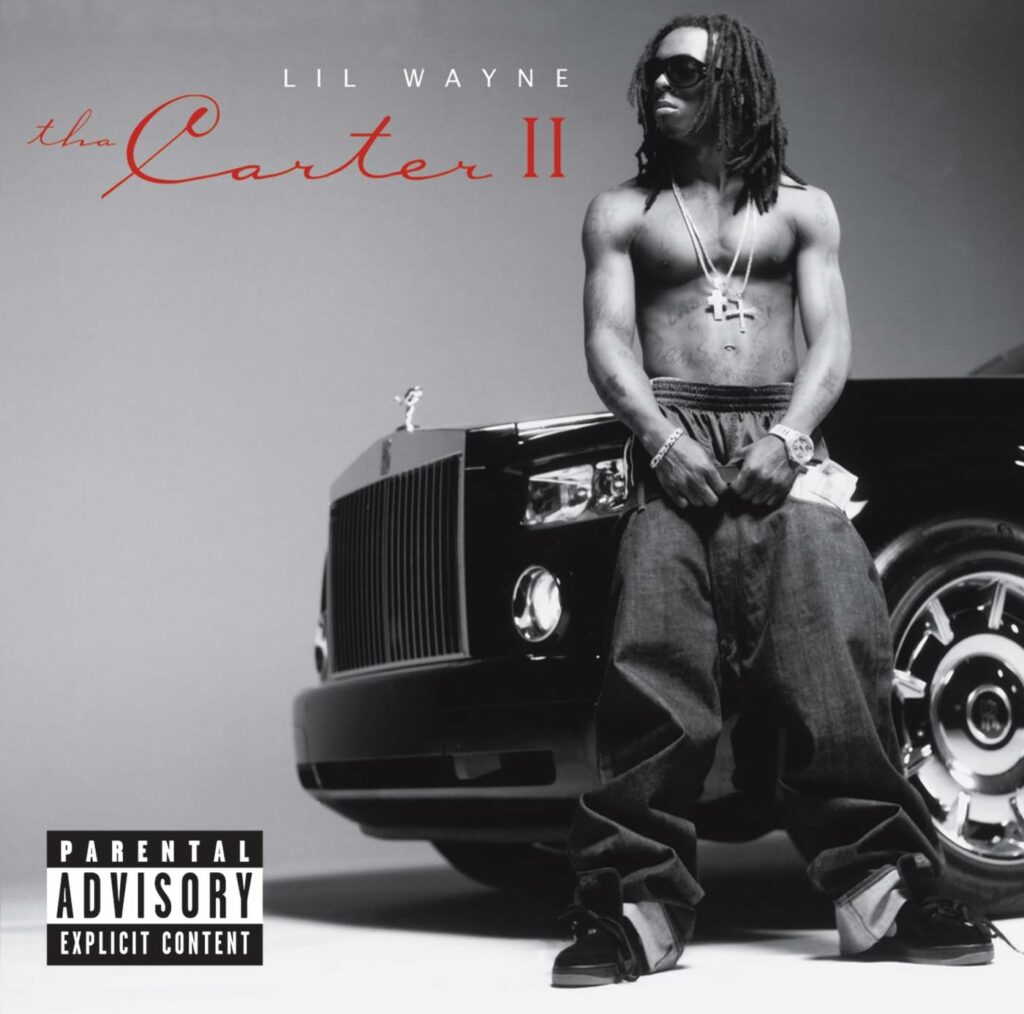
HIP-HOP STAR
Since moving to Goodwood, where production began in 2003, Rolls-Royce strengthened its ties with contemporary music. By 2016, it had become the most name-checked brand in song lyrics, driven in part by the meteoric rise of hip-hop.
Pharrell Williams and Snoop Dogg would famously feature a Phantom VII in the 2004 music video for Drop It Like It’s Hot, which would top the US Billboard Hot 100 for three weeks and commence Phantom’s lasting connection with the genre’s most influential artists.
50 Cent appeared in the TV series Entourage in a Phantom VII Drophead Coupé – a scene that would go on to become a widely shared meme – and Tha Carter II by Lil Wayne is one of many albums to feature Phantom on its cover.
Hip-hop has also played a key role in popularising one of the marque’s most distinctive features: the famed Starlight Headliner. The phrase ‘stars in the roof’ – and its variations – recurs in rap lyrics and has become a suitably poetic shorthand for Rolls-Royce ownership.
So let that be your guide. Bar a lottery win, a number one album just might be your most direct route to Rolls-Royce Phantom ownership. Maybe start choosing that colour scheme now, to avoid delay later.
